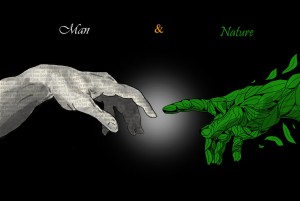Part and whole; connections and interactions
FORM – A WHOLE or PARTS?
The topic of debate seem to be whether “forms” (in general) are a result of a general rule (a whole) that contains or parts that mould the whole.
D’Arcy Thompson in his book On Growth and form describes how the form of living organisms have a general mathematical equation of “path” which may be deformed to form variants of the same ”type” due to the action of various external forces. His method also corroborates the parallel existence of different “types“. He also argues that just as the external from is deformed, the internal organs also respond to this general deformation of form. Evidently this suggests an arborescent or top-down system.
While Deleuze and DeLanda thinks otherwise. They assert a bottom-up or rhizome system where each individual (at whatever scale) is capable of altering the whole although the extent may vary and the end result may even be unintentional (as suggested by Steven Johnson in the concept of “emergence”).
It is easy to be step into the deception that the Thompson’s work is in strict contradiction with the rest. However, if we look more deeply we see that he leaves the explanation of “single case” to the existence of rhizomatic properties within a whole and also the interaction of parts with the environment. It is to be noted that his argument about the existence of parallel “types” is in sync with idea of “multiplicity”.
One must argue that if the purpose of “form” at whatever level it may be, is to exist (stabilize) and to thrive (grow) then, there must be a ‘general rule’ just as there is a ‘general purpose’. The “single case” however is definitely an outcome of individual/parts/inputs/data etc. and their interactions integrated into this general form. It is fair to argue that if the interaction between 2 parts have an effect on each of them and if interaction of parts to environment affects the parts, then there should be a counter effect of this on the environment as well. Therefore, the process of form-making becomes more and more specific with the introduction of time as yet another factor of interaction (an example would be evolution). Another simple eg: The purpose of every city is to live and thrive (general rule) depending on its environment (external factors) individuals living within them interact and form settlements, continued interactions over time forms culture, increases demands and slowly other forces* social, economic, political and technology etc. also forms part of the interaction forming rhizomes causing emergence, but all this happens on general whole.
*Forces acting on a whole, DeLanda says looking from this perspective one can even redefine history.
I believe that the idea of “parametics” should be made use of in this sense. Where the architect is the one aware of the general rules and is able to program (taking into account the forces) and work with machines (as suggested by Negroponte in Toward a theory of Architecture machines) to come up with multiple “creative” solutions to the problems of “form” at any level of human existence.
Topic of interest: What is the prevailing “general” form type of a given city. Is it possible to categorize them as tree and rhizome? If the relationship in more complex how can we understand the general growth pattern?


